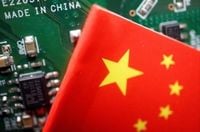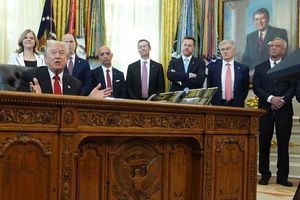In a move that signals a seismic shift in the global rare earths supply chain, Ionic Rare Earths, an Australian critical minerals developer, has inked a high-profile memorandum of understanding with Missouri-based US Strategic Metals (USSM) to build a state-of-the-art rare earth recycling and processing facility in Missouri. The agreement, announced on November 11, 2025, at the Australian Embassy in Washington, D.C., is the latest salvo in a mounting international effort to reduce the world’s overwhelming dependence on China for the rare earth elements that power everything from electric vehicles to defense systems.
According to Mining.com, the non-binding deal will see the two companies collaborate at USSM’s fully permitted 1,800-acre site in Missouri. The facility will deploy Ionic’s patented magnet recycling technology, which is capable of extracting high-value materials from end-of-life components—think electric motor magnets and wind turbine generators. The focus will be on producing high-purity, separated magnet rare earth oxides, including neodymium and praseodymium (NdPr), as well as heavy rare earths like dysprosium, terbium, samarium, gadolinium, and holmium. Many of these elements have recently come under new Chinese export restrictions, making alternative sources more urgent than ever.
“Magnet recycling is the fastest and lowest-cost pathway to developing an ex-China rare earth supply chain in the United States,” said Tim Harrison, managing director of Ionic Rare Earths, in a joint statement quoted by Mining.com. Harrison emphasized that Ionic’s UK-based recycling technology has already proven itself at the company’s Belfast plant and can cut emissions by up to 61% compared to traditional mining. “Now is the time to accelerate this technology,” he added. “We can build globally to offer a resilient supply of high-purity rare earth oxides, delivered sustainably thanks to our proven low-emission processes.”
Stacy Hastie, chief executive of US Strategic Metals, echoed the sentiment, telling The Armchair Trader, “Our Missouri operations are designed to meet America’s demand while collaborating with partners dedicated to responsible and secure sourcing. Working with IonicRE, we aim to accelerate technological progress and shape the future of domestic critical mineral supply chains.”
This partnership is more than a business deal—it’s a strategic maneuver in a broader geopolitical contest. The agreement follows the signing of the U.S.–Australia Critical Minerals Framework last month, a pact between President Donald Trump and Australian Prime Minister Anthony Albanese. That framework commits both nations to jointly invest at least $1 billion toward an $8.5 billion pipeline of critical mineral projects, all aimed at countering China’s dominance in the sector. The deal is also part of a wider effort under Executive Order 14241 to expand domestic mineral production and strengthen supply chains through the Quadrilateral Security Dialogue, which brings together the U.S., Australia, Japan, and India.
Why all the fuss? The answer is simple: rare earths are the backbone of modern technology. Permanent magnets made from rare earth metals—especially neodymium, praseodymium, and dysprosium—are essential for electric vehicle motors, renewable energy turbines, and advanced defense systems. Yet, as reported by Maeil Business Newspaper, the world’s rare earth supply chain is almost entirely dependent on China, which accounts for 80-90% of global permanent magnet production. South Korea, for example, sourced 89.4% of its rare earth imports and 47% of its rare earth compounds from China between January and September 2025, with some high-value elements exceeding 95% dependence.
Such overwhelming reliance has put automakers and technology firms on edge. Hyundai Motor Company, for instance, launched a company-wide “de-China” strategy in October 2024, aiming to reduce its dependence on Chinese rare earths by 2026. According to a closed investor call cited by Maeil Business Newspaper, Hyundai claims it has enough rare earth inventory to keep its electric and hybrid car lines running for at least a year without interruption. Still, the company is actively scouting alternative suppliers and investigating new production sites for critical materials like permanent magnets and cobalt.
Other major economies are also scrambling to shore up their supply chains. The United States has invested $1.1 billion in rare earth deposits in Central Asia, while the European Union aims to process over 40% of its key minerals domestically by 2030, forging new partnerships with resource-rich countries like Canada, Chile, and Argentina. Japan has signed a rare earth mining agreement with the U.S. and plans to mine 350 tons a day near Minamitori Island by 2027. India, meanwhile, is offering triple incentives to foster its rare earth magnet industry and is ramping up research and development to achieve technological independence. South Korea, not to be left behind, has launched a public-private task force to address rare earth supply chain vulnerabilities and is exploring joint mineral investments with Australia, Vietnam, and Malaysia.
But the risks of overreliance on China aren’t just theoretical. In a recent incident reported by Maeil Business Newspaper, China imposed export restrictions on semiconductor components, disrupting the supply of automotive power semiconductors and forcing companies like Honda to cut production in North America. While Hyundai managed to avoid immediate setbacks thanks to its stockpiled inventory, experts warn that future disruptions could pose existential threats to production stability and technological competitiveness. “This is a structural crisis beyond a simple one-off shortage, given that the supply chain of strategic resources such as rare earths and semiconductors is shaking at the same time,” said Kim Pil-soo, professor of Future Automotive at Daelim University. “If we fail to reduce our dependence on China for raw materials and core parts at a time when the global automobile industry is rapidly reorganized into electricity, we could be threatened not only with technological competitiveness but also with production stability in the future.”
Against this backdrop, the Ionic Rare Earths–US Strategic Metals agreement stands out as a potential game-changer. By leveraging recycling technology to recover rare earths from used components, the Missouri facility could provide a more sustainable and secure supply of these critical materials—not just for the U.S., but for the entire global market. Brett Lynch, executive chairman of Ionic Rare Earths, called the Missouri project “an important step forward in building a secure and sustainable ex-China rare earths supply chain in the world’s largest economy.”
With governments and industries racing to secure the metals that underpin both green technologies and national security, the Missouri plant could mark the beginning of a new era—one where supply chain resilience is built not just on stockpiles and contracts, but on innovation and international collaboration.




